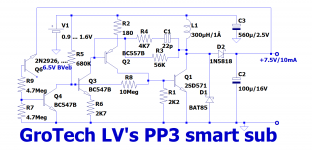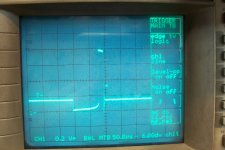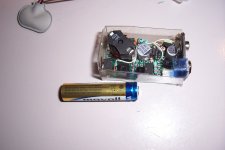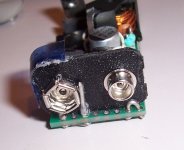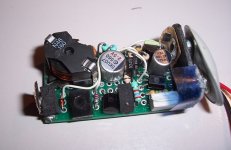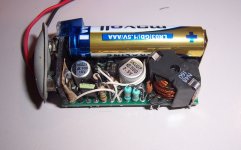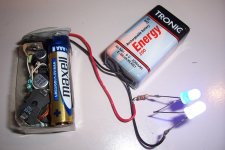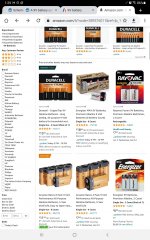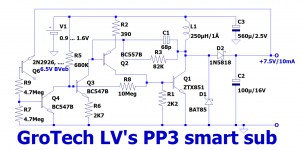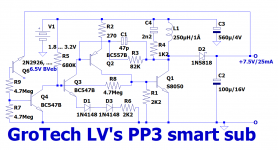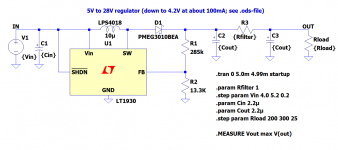A few years ago, you could find any usual type of battery almost anywhere: news agents, sweets shops, grocery stores and even Ikea.
Nowadays, they still store batteries, but in two flavors only: AA and AAA.
OK, they are cheap and reasonably good, but when you need something else, like a PP3, what do you do ?
This problem has been exacerbated by the pandemia, and at some point, I found myself short of these batteries, to the point I had to swap the good or rechargeable batteries between instruments.
Fortunately, the difficulties have eased, but I have developed a substitute anyway.
My wishlist was rather stringent:
*The sub had to be completely transparent, functionally, electrically and mechanically: it had to replace the PP3 completely and perfectly.
*It had to use a single cell as primary power, to avoid issues of unbalancing and leakage under deep discharge.
*The shelf life of the primary battery should remain unaffected.
*It had to offer a longevity at least equal to the replaced battery.
*It had to be simple, and use only commodity components, no special semi or IC, no custom magnetics.
It was a tall order, maybe a bit too tall: the only cell that can (just) fit into a PP3 volume is the AAA, but an AAA doesn't store the same energy as a PP3.
The project was thus doomed for basic energy density reasons, but I went on anyway, as a reduced capacity sub could still be useful.
Designing a self-oscillating converter is not an easy task, but when it is combined with the other requirements, like the low and variable supply voltage (between 1.6V and 0.9V for a typical alkaline cell), the need to maintain a good efficiency for loads varying from 0 to the max (=an infinite ratio), the minimal complexity and the absence of "fancy" parts, it becomes really difficult.
Here is my take on the subject:
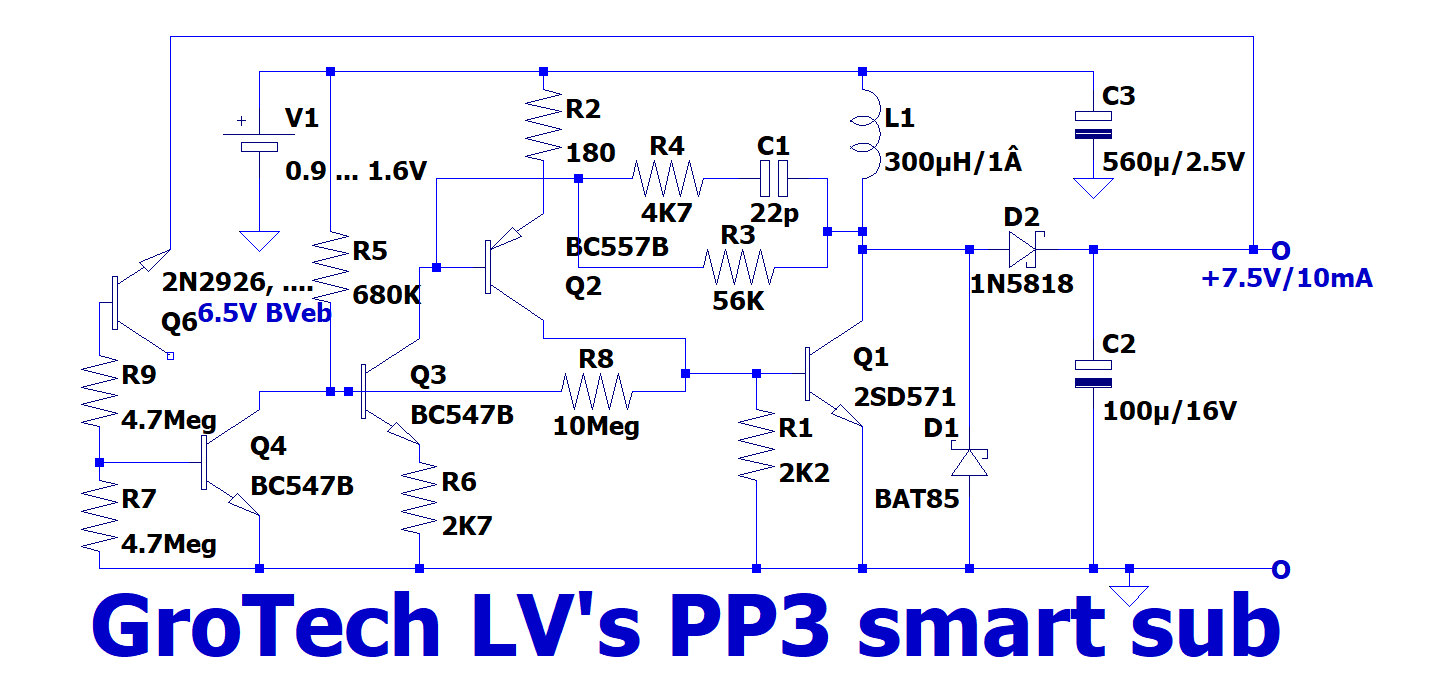
It is a PFM converter, the only scheme practical in this case: it is impossible to afford more switching events than necessary, considering the CV²F losses.
Since the output voltage is regulated, I opted for 7.5V instead of 9V: all of the equipments designed for 9V can operate down to ~7V, and 95% of them have no regulation, or a linear regulator meaning the extra voltage is simply shaved off and wasted.
As the sub is a switcher, the 1.5V gain translates into an apparent 1/6th increase of the capacity: around 16%, not to be scorned at, and compensating partly for the reduced capacity.
The circuit is designed to supply 0 to 10mA, and the EOL voltage of the AAA cell is 0.9V: the official value, a far cry from what most of equipments are capable of. For a 9V battery, it should be 5.4V, but apart from the instruments I have myself designed, I have never seen anything approaching it.
The performances do not seem to shine particularly, but they have to be seen within the requirements context mentioned earlier.
The efficiency with a 7.5mA load and a 1.4V battery voltage (mid-life) is 74%.
The no-load drain current is 25µA (at 1.4V input). It slightly decreases for higher battery voltages, and increases for lower voltages, meaning the quiescent power is ~constant.
The performances (and max output) can be substantially improved by using a ZTX transistor, but I consider them as too fancy for a really universal project (I will publish a ZTX version anyway).
Here are some pics of my build:
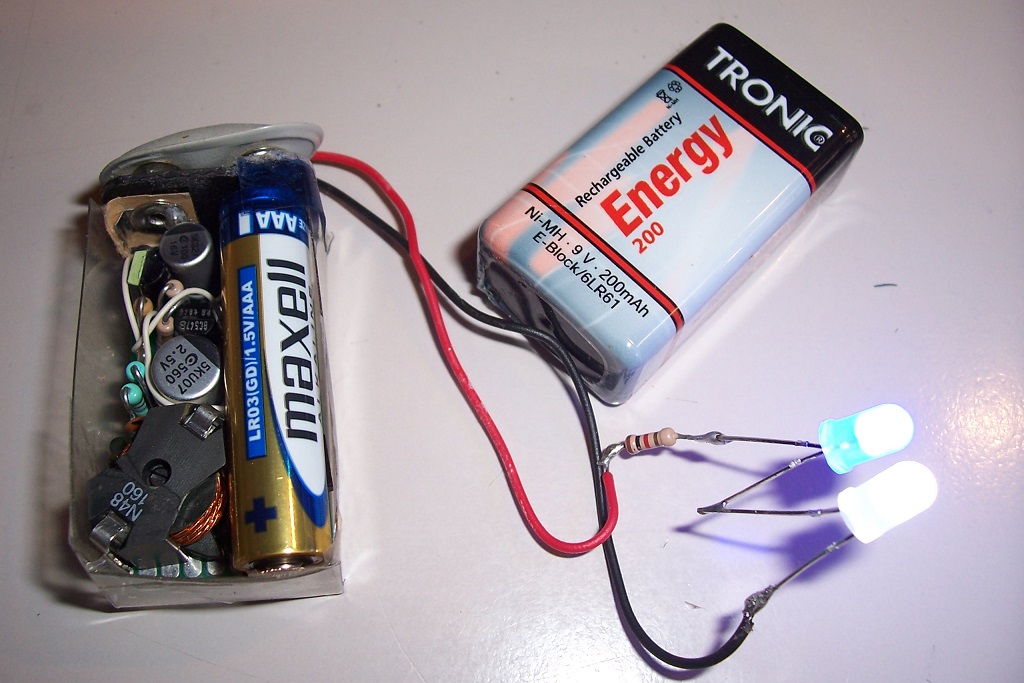
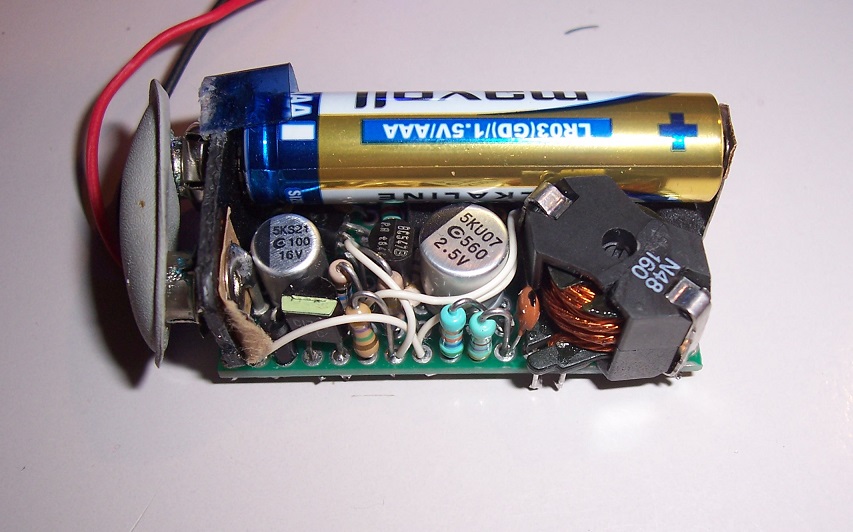
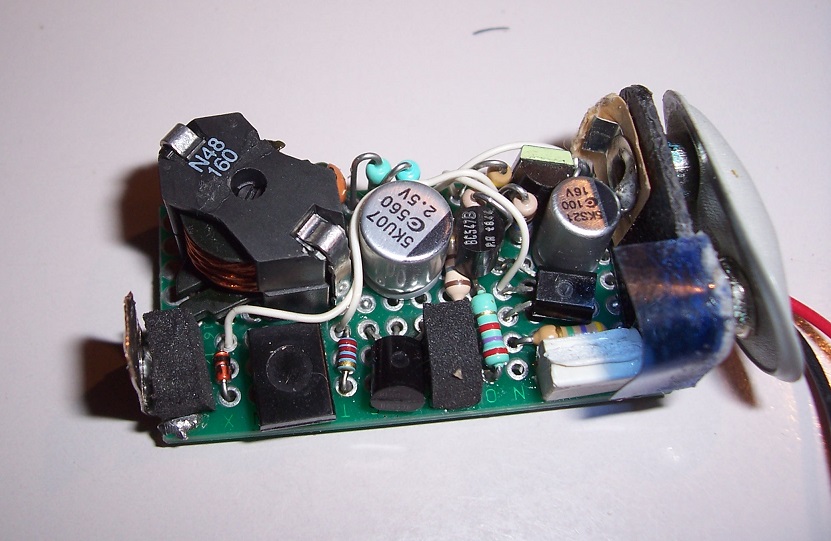
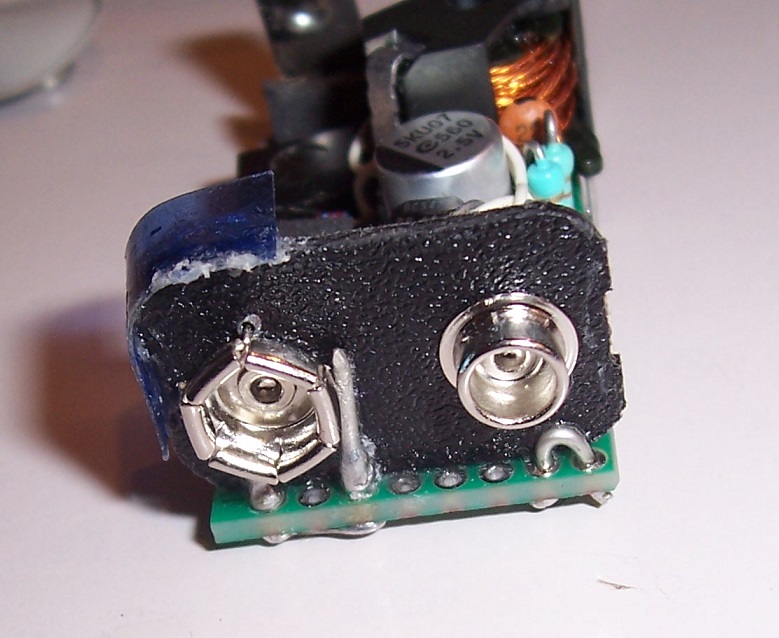
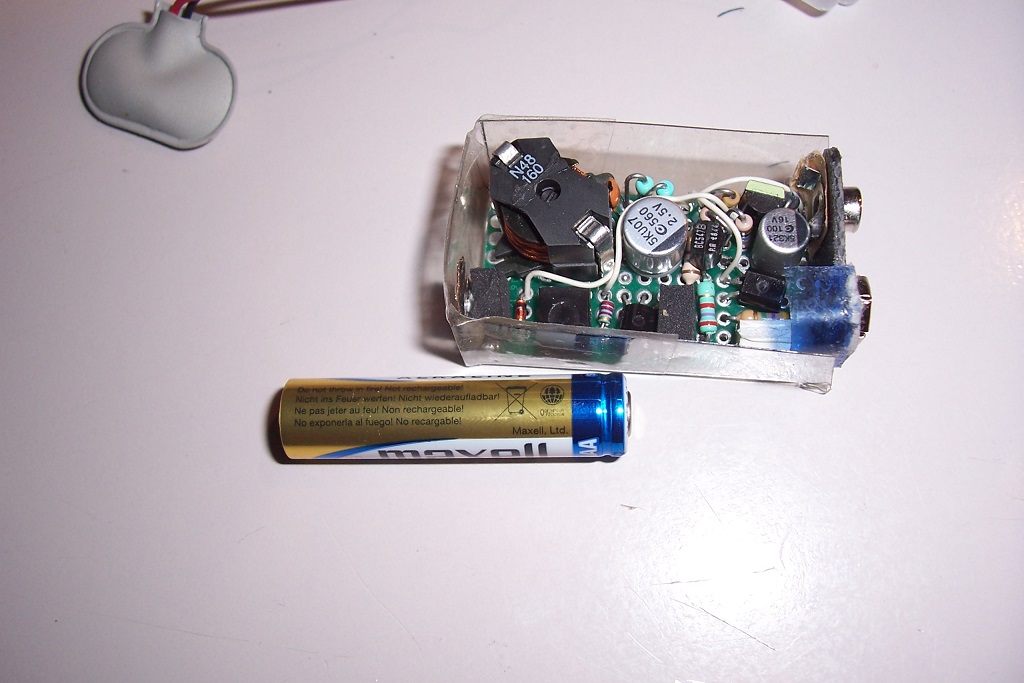
This is the shape of a typical cycle, taken at a few mA load:
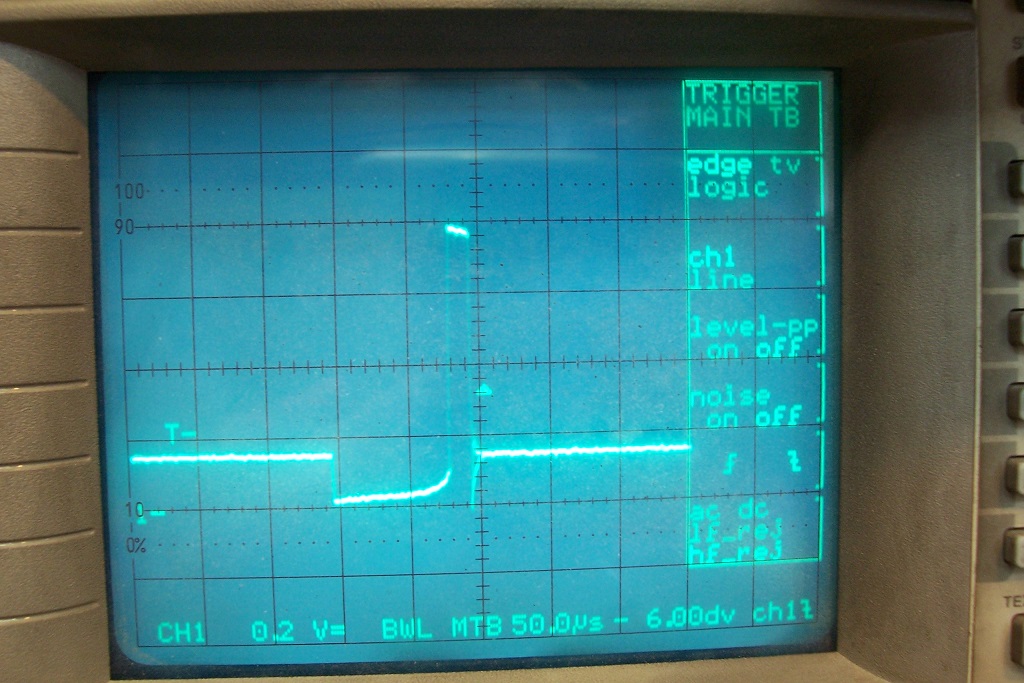
It basically remains the same for any load, but the repetition rate under no load is 1~2Hz, and ~10kHz at the max load
Nowadays, they still store batteries, but in two flavors only: AA and AAA.
OK, they are cheap and reasonably good, but when you need something else, like a PP3, what do you do ?
This problem has been exacerbated by the pandemia, and at some point, I found myself short of these batteries, to the point I had to swap the good or rechargeable batteries between instruments.
Fortunately, the difficulties have eased, but I have developed a substitute anyway.
My wishlist was rather stringent:
*The sub had to be completely transparent, functionally, electrically and mechanically: it had to replace the PP3 completely and perfectly.
*It had to use a single cell as primary power, to avoid issues of unbalancing and leakage under deep discharge.
*The shelf life of the primary battery should remain unaffected.
*It had to offer a longevity at least equal to the replaced battery.
*It had to be simple, and use only commodity components, no special semi or IC, no custom magnetics.
It was a tall order, maybe a bit too tall: the only cell that can (just) fit into a PP3 volume is the AAA, but an AAA doesn't store the same energy as a PP3.
The project was thus doomed for basic energy density reasons, but I went on anyway, as a reduced capacity sub could still be useful.
Designing a self-oscillating converter is not an easy task, but when it is combined with the other requirements, like the low and variable supply voltage (between 1.6V and 0.9V for a typical alkaline cell), the need to maintain a good efficiency for loads varying from 0 to the max (=an infinite ratio), the minimal complexity and the absence of "fancy" parts, it becomes really difficult.
Here is my take on the subject:
It is a PFM converter, the only scheme practical in this case: it is impossible to afford more switching events than necessary, considering the CV²F losses.
Since the output voltage is regulated, I opted for 7.5V instead of 9V: all of the equipments designed for 9V can operate down to ~7V, and 95% of them have no regulation, or a linear regulator meaning the extra voltage is simply shaved off and wasted.
As the sub is a switcher, the 1.5V gain translates into an apparent 1/6th increase of the capacity: around 16%, not to be scorned at, and compensating partly for the reduced capacity.
The circuit is designed to supply 0 to 10mA, and the EOL voltage of the AAA cell is 0.9V: the official value, a far cry from what most of equipments are capable of. For a 9V battery, it should be 5.4V, but apart from the instruments I have myself designed, I have never seen anything approaching it.
The performances do not seem to shine particularly, but they have to be seen within the requirements context mentioned earlier.
The efficiency with a 7.5mA load and a 1.4V battery voltage (mid-life) is 74%.
The no-load drain current is 25µA (at 1.4V input). It slightly decreases for higher battery voltages, and increases for lower voltages, meaning the quiescent power is ~constant.
The performances (and max output) can be substantially improved by using a ZTX transistor, but I consider them as too fancy for a really universal project (I will publish a ZTX version anyway).
Here are some pics of my build:
This is the shape of a typical cycle, taken at a few mA load:
It basically remains the same for any load, but the repetition rate under no load is 1~2Hz, and ~10kHz at the max load
Attachments
Some additional details:
Q6 is used as a zener: to achieve a good micropower performance, the leakage current under the knee voltage has to be absolutely minimal.
Due to the voltage boosting and the efficiency, a single µA leakage on the output side translates into ~10µA at the input (the total quiescent current being 25µA).
Ordinary, diffused zeners have a significant leakage below their knee voltage, and are not suitable.
The B-E junction of a planar transistor has a very sharp breakdown, and a negligible leakage below, making it ideal for such an application.
The voltage is not exactly specified, and has to be measured (with a 12V source and a 10K limiting resistor for example).
Most modern transistors are in the 7~12V range, but older types cover 5 to 7V.
An authentic 2N2926 will have a voltage in the correct range, but you will still need to pick the right one.
Many other vintage transistors types could be suitable, but they need to be tested, which is not difficult.
The output voltage can be determined by choosing a transistor having a BVbe=Vout-1V.
The circuit is not completely deterministic. The values have been selected to ensure a reliable operation with normal spread and variations, but a part of black magic remains.
The most critical aspect is the way the end of cycle behaves: when the inductor has released all of its energy into the load (~center of the screen on the oscillogram) and its voltage collapses, it has to return to the quiescent potential, V+in.
If residual energy is stored, in parasitic capacitances for example, it will cause undershoot and/or ringing: some is visible, but it is insufficient to cause problems.
If the undershoot is too large, it will restart a new cycle just after the previous one, without the pause required for PFM. Instead, the circuit will degenerate into classic PWM, which is much more power-hungry at light loads.
The capacitance of the inductor, diode and transistor will aggravate the effect.
The diode across the C-E of the transistor clamps the undershoot to GND, limiting the risk, but not eliminating it completely.
If too much ringing is present and causes unwanted retrigger, a snubber can be added in // with the inductor: 1.5K-1.5nF for example.
If a heavy, pure resistive load is present at the output, the converter might have troubles starting: the 1N5818 will be forward-biased with a significant current, leading to a low dynamic resistance directly connected to the output filter cap, damping the inductor to the point of preventing the starting.
This situation is unlikely to present itself in real-world applications, but if you test the circuit on dummy loads, it could stall the converter (only for starting, it doesn't matter once it has started).
Real devices based on semiconductors generally draw a very low current at 1V or below, and will normally not cause problems
Q6 is used as a zener: to achieve a good micropower performance, the leakage current under the knee voltage has to be absolutely minimal.
Due to the voltage boosting and the efficiency, a single µA leakage on the output side translates into ~10µA at the input (the total quiescent current being 25µA).
Ordinary, diffused zeners have a significant leakage below their knee voltage, and are not suitable.
The B-E junction of a planar transistor has a very sharp breakdown, and a negligible leakage below, making it ideal for such an application.
The voltage is not exactly specified, and has to be measured (with a 12V source and a 10K limiting resistor for example).
Most modern transistors are in the 7~12V range, but older types cover 5 to 7V.
An authentic 2N2926 will have a voltage in the correct range, but you will still need to pick the right one.
Many other vintage transistors types could be suitable, but they need to be tested, which is not difficult.
The output voltage can be determined by choosing a transistor having a BVbe=Vout-1V.
The circuit is not completely deterministic. The values have been selected to ensure a reliable operation with normal spread and variations, but a part of black magic remains.
The most critical aspect is the way the end of cycle behaves: when the inductor has released all of its energy into the load (~center of the screen on the oscillogram) and its voltage collapses, it has to return to the quiescent potential, V+in.
If residual energy is stored, in parasitic capacitances for example, it will cause undershoot and/or ringing: some is visible, but it is insufficient to cause problems.
If the undershoot is too large, it will restart a new cycle just after the previous one, without the pause required for PFM. Instead, the circuit will degenerate into classic PWM, which is much more power-hungry at light loads.
The capacitance of the inductor, diode and transistor will aggravate the effect.
The diode across the C-E of the transistor clamps the undershoot to GND, limiting the risk, but not eliminating it completely.
If too much ringing is present and causes unwanted retrigger, a snubber can be added in // with the inductor: 1.5K-1.5nF for example.
If a heavy, pure resistive load is present at the output, the converter might have troubles starting: the 1N5818 will be forward-biased with a significant current, leading to a low dynamic resistance directly connected to the output filter cap, damping the inductor to the point of preventing the starting.
This situation is unlikely to present itself in real-world applications, but if you test the circuit on dummy loads, it could stall the converter (only for starting, it doesn't matter once it has started).
Real devices based on semiconductors generally draw a very low current at 1V or below, and will normally not cause problems
Pardon my ignorance, but are you just looking for 9V batteries and can't get them locally?
I ask, I'm in the US, and I haven't heard of availability limited to AA and AAA.
Amazon seems to have lots of 9V choice in different chemistries.
And these guys ship internationally.
9V battery
Sorry if I misunderstood your post.
I ask, I'm in the US, and I haven't heard of availability limited to AA and AAA.
Amazon seems to have lots of 9V choice in different chemistries.
And these guys ship internationally.
9V battery
Sorry if I misunderstood your post.
Attachments
Last edited:
I live in Europe, and I can order whatever I want, but for basic supplies, I like to go to a corner-shop or a mini-market, and get what I need in less than half an hour, without even using my car.
When you order from amazon et. al, you have to go through the chore of ordering (OK, from your sofa, but a chore all the same), you have to make arrangements for the reception of the parcel, be at home or pick it up somewhere.... maybe I am outdated, old-school, but I prefer to walk a few hundreds meters and get what I want almost instantly.
Even preferable (for me) is to have it in my personal stock: it is the reason why I have accumulated a huge stock of components over the years.
It goes against the "just in time" doctrine, and some of my stock is >40 years old, but it is still usable (as the prototype shows), and I find it very convenient.
Going online as soon as I need a paper-clip is not my philosophy, but I am probably a kind of a dinosaur nowadays.
I always have the option of going a bit further, to a more specialized store, but this requires the car and a trip of ~one hour in total, something I don't like.
Having "substitutes" that I can refill easily by walking a few hundreds meters is preferable (for me at least)
When you order from amazon et. al, you have to go through the chore of ordering (OK, from your sofa, but a chore all the same), you have to make arrangements for the reception of the parcel, be at home or pick it up somewhere.... maybe I am outdated, old-school, but I prefer to walk a few hundreds meters and get what I want almost instantly.
Even preferable (for me) is to have it in my personal stock: it is the reason why I have accumulated a huge stock of components over the years.
It goes against the "just in time" doctrine, and some of my stock is >40 years old, but it is still usable (as the prototype shows), and I find it very convenient.
Going online as soon as I need a paper-clip is not my philosophy, but I am probably a kind of a dinosaur nowadays.
I always have the option of going a bit further, to a more specialized store, but this requires the car and a trip of ~one hour in total, something I don't like.
Having "substitutes" that I can refill easily by walking a few hundreds meters is preferable (for me at least)
Last edited:
Here are two additional versions:
First, the ZTX version. It has a higher output current, a better efficiency and can work at even lower voltages:
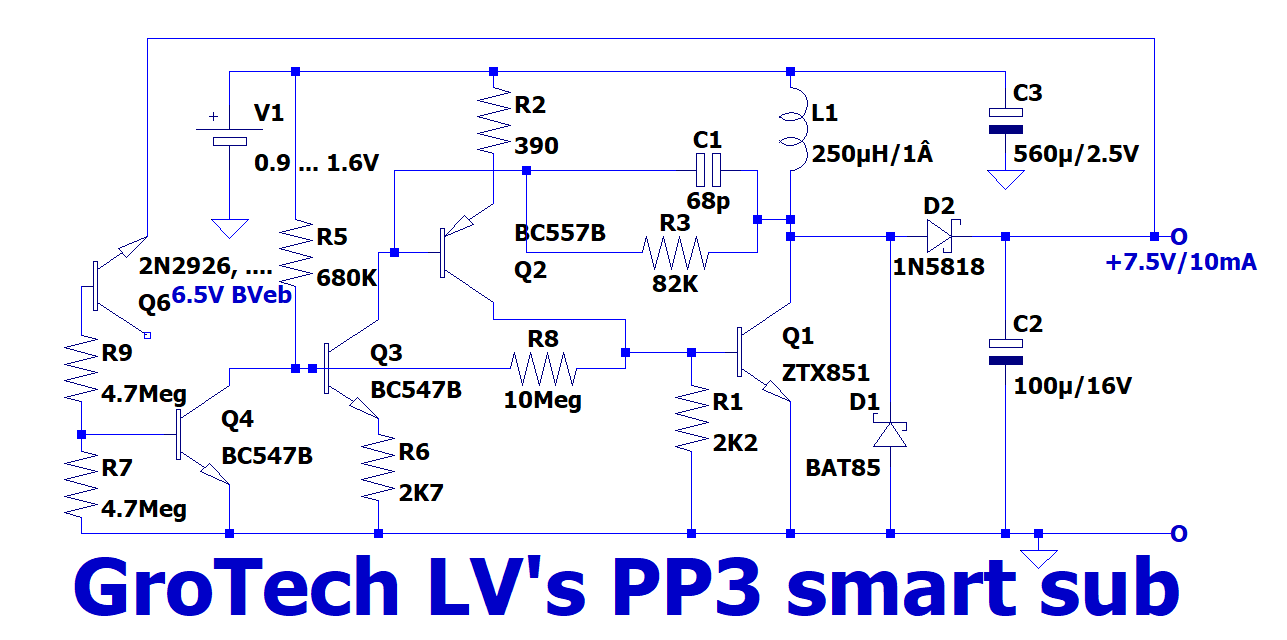
This one is a two-cell version. It has a double capacity, obviously, a higher output current, and contents itself with 14µA quiescent current and lower grade transistors: a cheap Chinese S8050 is sufficient.
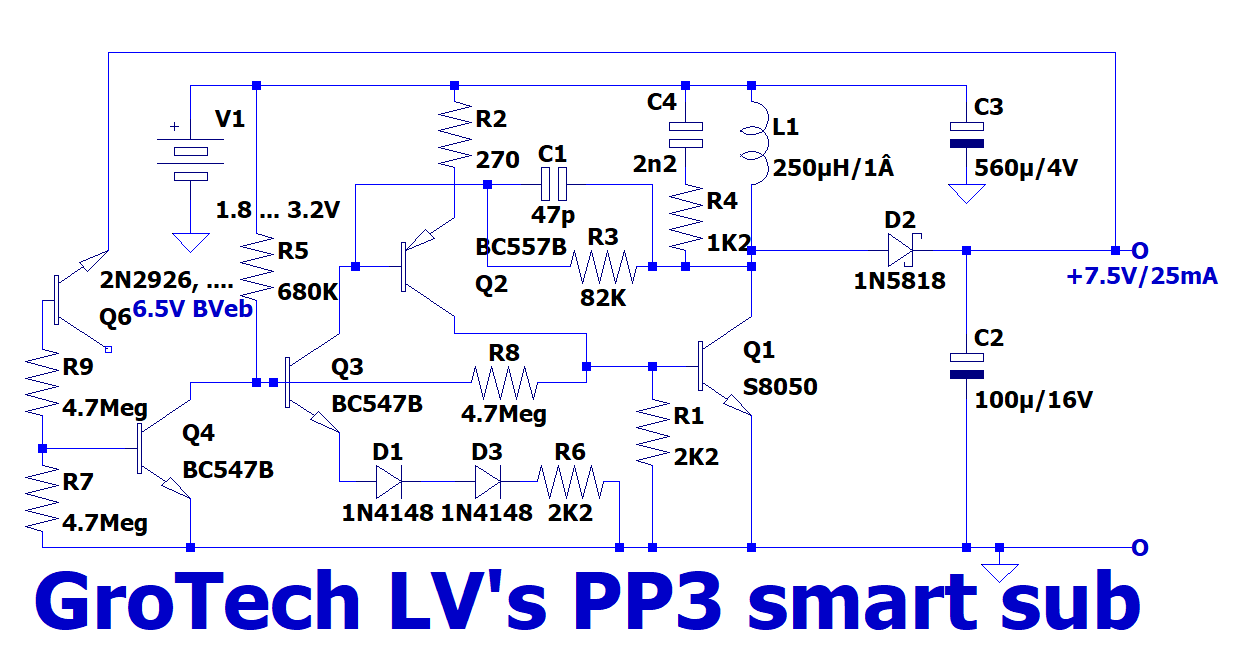
Note that all versions can use better transistors than specified: here, a 2SD571 or a ZTX851 also works, and the original single-cell version also works with the ZTX.
Some figures: the typical capacity of a AAA alkaline element is 1200mAh. For the PP3 battery, the figure is between 500 and 600mA for bona fide examples (dodgier types can have a smaller capacity).
Since there are 6 elements in the PP3, the equivalent capacity is 3300mAh.
The raw capacity of the single-cell sub is thus 1200/3300= 36% of the PP3.
The sub has a limited efficiency, but thanks to the regulation trick and its ability to work down to the official, 0.9V EOL voltage, the losses are broadly compensated.
For the two-cell version, the capacity is at least 72%, more in fact because the efficiency is better.
The shelf life of the single-cell is 1200mAh/0.025µA=48000 hours =2000 days = 5.5 years.
For the two-cell version, it is close to 10 years
First, the ZTX version. It has a higher output current, a better efficiency and can work at even lower voltages:
This one is a two-cell version. It has a double capacity, obviously, a higher output current, and contents itself with 14µA quiescent current and lower grade transistors: a cheap Chinese S8050 is sufficient.
Note that all versions can use better transistors than specified: here, a 2SD571 or a ZTX851 also works, and the original single-cell version also works with the ZTX.
Some figures: the typical capacity of a AAA alkaline element is 1200mAh. For the PP3 battery, the figure is between 500 and 600mA for bona fide examples (dodgier types can have a smaller capacity).
Since there are 6 elements in the PP3, the equivalent capacity is 3300mAh.
The raw capacity of the single-cell sub is thus 1200/3300= 36% of the PP3.
The sub has a limited efficiency, but thanks to the regulation trick and its ability to work down to the official, 0.9V EOL voltage, the losses are broadly compensated.
For the two-cell version, the capacity is at least 72%, more in fact because the efficiency is better.
The shelf life of the single-cell is 1200mAh/0.025µA=48000 hours =2000 days = 5.5 years.
For the two-cell version, it is close to 10 years
Attachments
Years ago, I tried to use one of those inductor-less charge pump chips to invert a single 9V battery for +/-9V for an op-amp as a microphone pre-amp. But the oscillator frequency was audible and I could never get the switching noise out of the audio so I had to revert to a second battery.
Does the inductor need to be that large? 9V batteries are common here for smoke detectors, and DVMs, etc.
Do you have any lithium charging circuits? A lithium charger and PS for a pre-amp would be cool.
Does the inductor need to be that large? 9V batteries are common here for smoke detectors, and DVMs, etc.
Do you have any lithium charging circuits? A lithium charger and PS for a pre-amp would be cool.
The inductor is hugely oversized, but the bog-standard drum core inductors I had in my stock were really too crappy.
The ideal would be a capsule-format SMD inductor: it would be much smaller, and they can be quite good, probably better than this behemoth, but I didn't have a value that large.
The noise from any type of converter can be pervasive, especially in a preamp. This has to be taken into account from the very start, because if something like the GND arrangement or the component placement is wrong, it is very difficult to remedy.
I don't have many lithium circuits examples, and I have nothing suitable for a preamp.
If the preamp has a power switch, PFM is not necessary and the converter can operate in classic, continuous PWM mode at an ultrasonic frequency: leakage might still be there and even larger, but it won't be noticeable
The ideal would be a capsule-format SMD inductor: it would be much smaller, and they can be quite good, probably better than this behemoth, but I didn't have a value that large.
The noise from any type of converter can be pervasive, especially in a preamp. This has to be taken into account from the very start, because if something like the GND arrangement or the component placement is wrong, it is very difficult to remedy.
I don't have many lithium circuits examples, and I have nothing suitable for a preamp.
If the preamp has a power switch, PFM is not necessary and the converter can operate in classic, continuous PWM mode at an ultrasonic frequency: leakage might still be there and even larger, but it won't be noticeable
That's remarkable how you have made a miniature circuit from all discrete through hole components.
I bet you can reuse old AA cells from appliances that won't operate down to the 0.9V.
I seem to have bad experiences of PP3 size cells -
Flat from sealed, within date package (I'd had it a while, no receipt, couldn't return).
Rechargable that wouldn't charge (got a refund).
I bet you can reuse old AA cells from appliances that won't operate down to the 0.9V.
I seem to have bad experiences of PP3 size cells -
Flat from sealed, within date package (I'd had it a while, no receipt, couldn't return).
Rechargable that wouldn't charge (got a refund).
Yeah, there are numbers of dodgy types around and good ones are relatively expensive considering the energy they store.
Two good reasons to use a substitute.
Small, cylindrical elements do not have these kind of issues, and are dirt-cheap.
Larger types, like D cells are often dodgier: a D element can have the capacity of a C.
Obviously, some of the active ingredients have replaced by vacuum.
Two good reasons to use a substitute.
Small, cylindrical elements do not have these kind of issues, and are dirt-cheap.
Larger types, like D cells are often dodgier: a D element can have the capacity of a C.
Obviously, some of the active ingredients have replaced by vacuum.
As I´m more lazy and less experienced a circuit designer than Elvee
I used a LT1930 IC to convert 5V to 29V at 60mA. (USB power bank powered ringlight for a macro lens)
All on a little SMD perfboard about the size of a fingernail.
Worked really well with very high efficiency.
This chip needs 2.6V at it´s input though so one cell wouldn´t do.
I used a LT1930 IC to convert 5V to 29V at 60mA. (USB power bank powered ringlight for a macro lens)
All on a little SMD perfboard about the size of a fingernail.
Worked really well with very high efficiency.
This chip needs 2.6V at it´s input though so one cell wouldn´t do.
Attachments
Sorry russc, should have posted a picture too and thanks Elvee!no idea how to read an asc file.
Hope this is not too off-topic but wanted to show that (obvious to some) there are tiny chips out there that can easily fit: that said I can´t seem to find many with output voltages >6V and input voltages <1V.
LT1615 is one that has Vin_min>=1V and can put out 34V max.
Right on the edge for a single cell. The circuit wouldn´t operate when there is still considerable charge left.
And of course its more expensive than all transistors of Elvee´circuit together...
TPS61220 can take input voltages down to 0.7V but has Vout_max=6V and is relatively cheap at ~1€...
I live in Europe
I too, and yesterday I bought two for Multimeter / HDMI / Network cable testers and didn't notice low availability. I use them also on Sennheiser wireless mikes. It was a small village super-market nearby. Of course the shelfs have always more the round types, but they can be found. The ones that seem disappeared are those square 4.5V lantern ones. Tomorrow I have to buy paint and will investigate.
- Home
- Amplifiers
- Power Supplies
- A 9V battery substitute
